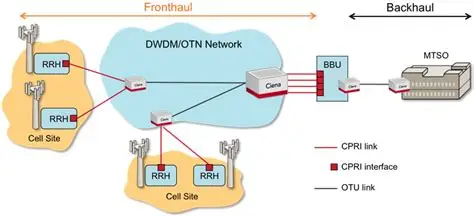
5G Fronthaul and Backhaul: Optical Module Solutions
5G isn’t just about faster smartphones. Behind the scenes, it’s a complex network of fiber links connecting base stations, aggregation sites, and core networks. If you’ve been involved in a 5G rollout, you’ll know that fronthaul and backhaul are the lifelines of the entire system.
In both cases, optical modules are the critical connectors — they determine how efficiently and reliably data flows across the network. Having worked with operators and integrators in multiple 5G projects, I can say that choosing the right optics isn’t about “one size fits all.” It’s about matching technology to the very specific needs of each link.
1. Understanding Fronthaul and Backhaul
Fronthaul:
- Connects the baseband unit (BBU) or centralized unit (CU) to the remote radio unit (RRU) at the cell site.
- Requires very low latency and high bandwidth to transport raw or lightly processed radio signals.
- Distances can vary from a few hundred meters to several kilometers.
Backhaul:
- Connects the cell site (or aggregation point) back to the core network.
- Carries aggregated traffic from multiple fronthaul links, so capacity requirements are higher but latency is less critical than fronthaul.
- Distances often range from 10 km to 80+ km, depending on network topology.
2. Optical Module Requirements for 5G Fronthaul
- High Speed per Lane: Commonly 10G, 25G, and now 50G modules to match 5G NR requirements.
- Low Latency: Modules need minimal internal processing delay to meet fronthaul timing constraints.
- Temperature Tolerance: Many RRUs are installed outdoors; industrial-grade optics (–40°C to +85°C) are often required.
- Form Factors: SFP28 for 25G fronthaul is the workhorse, but QSFP28 can be used in high-density aggregation nodes.
- Fiber Type: Mostly single-mode, often with duplex LC connectors.
Typical Solutions:
- 25G SFP28 LR (up to 10 km) for single-mode fiber links.
- 25G BiDi for fiber-constrained deployments — uses a single fiber strand for bidirectional transmission.
- CWDM/DWDM SFP28 for color-coded wavelength multiplexing when multiple fronthaul links share the same fiber.
3. Optical Module Requirements for 5G Backhaul
- Higher Aggregate Capacity: 100G, 200G, or even 400G optics for trunk links.
- Longer Reach: 40 km to 80 km typical, sometimes beyond with DWDM coherent optics.
- Wavelength Multiplexing: CWDM and DWDM are standard to maximize fiber utilization.
- Interoperability: Must work seamlessly with routers, switches, and transport equipment from multiple vendors.
Typical Solutions:
- 100G QSFP28 LR4 (10 km) or ER4 (40 km) for direct point-to-point connections.
- DWDM QSFP28 / CFP2-DCO coherent modules for metro or regional backhaul.
- 400G QSFP-DD LR8 / FR4 for high-capacity aggregation links.
4. Key Challenges and How Optical Modules Address Them
a. Fiber Scarcity
In urban areas, laying new fiber is expensive and slow. Solution:
- Use BiDi optics or DWDM/CWDM multiplexing to increase capacity per fiber.
b. Harsh Outdoor Conditions
Backhaul aggregation sites and fronthaul RRUs are often exposed to heat, cold, and humidity. Solution:
- Deploy industrial-grade optics with extended temperature ratings and ruggedized designs.
c. Synchronization Requirements
5G fronthaul relies on precise timing (IEEE 1588v2, SyncE). Solution:
- Use optics with low latency and minimal jitter, ensuring timing stability.
d. Power Consumption
High-density baseband hotels can have hundreds of optical ports. Solution:
- Select low-power optics to reduce cooling requirements and operating costs.
5. Case Example: Urban 5G Deployment
In a recent metro-area 5G rollout, the operator used 25G SFP28 CWDM modules for fronthaul to share a limited fiber path among multiple RRUs. For backhaul, 100G DWDM QSFP28 optics linked aggregation sites to the core over existing metro fiber. This combination allowed them to scale capacity without digging new trenches — saving months of work and significant capital expense.
6. Selecting the Right Optical Module for 5G
Before placing orders, network planners should confirm:
- Required Speed: 10G, 25G, 100G, 400G.
- Distance and Fiber Type: SMF vs MMF, link length.
- Form Factor Compatibility: SFP, QSFP, CFP, OSFP.
- Wavelength Plan: CWDM/DWDM channels, BiDi needs.
- Environmental Conditions: Commercial or industrial grade.
- Vendor Compatibility: Approved optics list vs open compatible.
Conclusion
5G fronthaul and backhaul networks may differ in distance, speed, and latency requirements, but both depend on optical modules that are precisely matched to the job. By understanding the specific technical demands of each segment, operators can choose optics that maximize performance, extend fiber life, and reduce total cost of ownership.
As 5G evolves toward higher capacity and lower latency targets, optical module innovation will continue to play a central role — from the tower to the core.